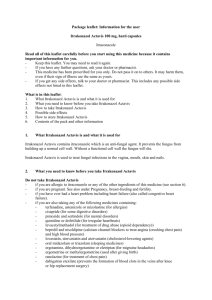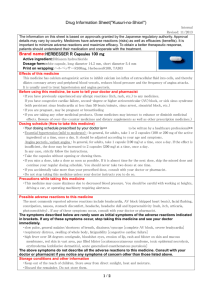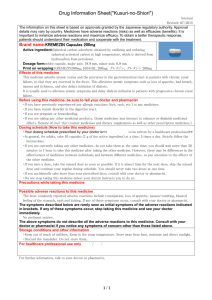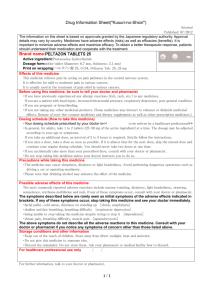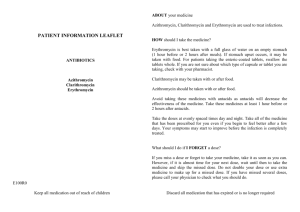Oxikodon Actavis capsule, hard ENG PL
advertisement
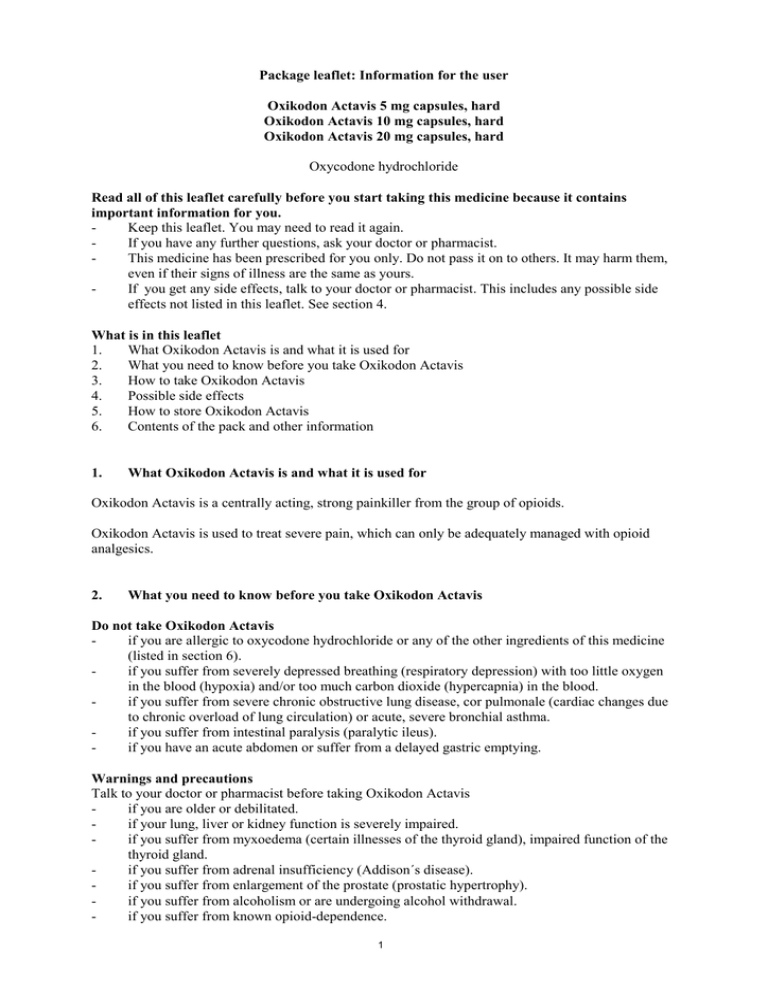
Package leaflet: Information for the user
Oxikodon Actavis 5 mg capsules, hard
Oxikodon Actavis 10 mg capsules, hard
Oxikodon Actavis 20 mg capsules, hard
Oxycodone hydrochloride
Read all of this leaflet carefully before you start taking this medicine because it contains
important information for you.
Keep this leaflet. You may need to read it again.
If you have any further questions, ask your doctor or pharmacist.
This medicine has been prescribed for you only. Do not pass it on to others. It may harm them,
even if their signs of illness are the same as yours.
If you get any side effects, talk to your doctor or pharmacist. This includes any possible side
effects not listed in this leaflet. See section 4.
What is in this leaflet
1.
What Oxikodon Actavis is and what it is used for
2.
What you need to know before you take Oxikodon Actavis
3.
How to take Oxikodon Actavis
4.
Possible side effects
5.
How to store Oxikodon Actavis
6.
Contents of the pack and other information
1.
What Oxikodon Actavis is and what it is used for
Oxikodon Actavis is a centrally acting, strong painkiller from the group of opioids.
Oxikodon Actavis is used to treat severe pain, which can only be adequately managed with opioid
analgesics.
2.
What you need to know before you take Oxikodon Actavis
Do not take Oxikodon Actavis
if you are allergic to oxycodone hydrochloride or any of the other ingredients of this medicine
(listed in section 6).
if you suffer from severely depressed breathing (respiratory depression) with too little oxygen
in the blood (hypoxia) and/or too much carbon dioxide (hypercapnia) in the blood.
if you suffer from severe chronic obstructive lung disease, cor pulmonale (cardiac changes due
to chronic overload of lung circulation) or acute, severe bronchial asthma.
if you suffer from intestinal paralysis (paralytic ileus).
if you have an acute abdomen or suffer from a delayed gastric emptying.
Warnings and precautions
Talk to your doctor or pharmacist before taking Oxikodon Actavis
if you are older or debilitated.
if your lung, liver or kidney function is severely impaired.
if you suffer from myxoedema (certain illnesses of the thyroid gland), impaired function of the
thyroid gland.
if you suffer from adrenal insufficiency (Addison´s disease).
if you suffer from enlargement of the prostate (prostatic hypertrophy).
if you suffer from alcoholism or are undergoing alcohol withdrawal.
if you suffer from known opioid-dependence.
1
-
if you suffer from inflammation of the pancreas (pancreatitis).
in conditions with increased brain pressure such as head injury.
if you suffer from disturbances of circulatory regulation.
if you suffer from colic of the bile duct and ureter.
if you suffer from low blood pressure or reduced blood volume,
if you suffer from epilepsy or have a seizure tendency.
if you take MAO inhibitors (for the treatment of depression).
if you have recently undergone a bowel-surgery or abdominal surgery.
if you suffer from an inflammatory bowel disorder.
Please talk to your doctor if any of these apply to you or if any of these conditions applied to you in
the past.
Oxikodon Actavis has a primary dependence potential. When used for a long time tolerance to the
effects may develop and progressively higher doses may be required to maintain pain control.
Chronic use of Oxikodon Actavis may lead to physical dependence and a withdrawal syndrome may
occur upon abrupt cessation. When a patient no longer requires therapy with oxycodone
hydrochloride, it may be advisable to taper the dose gradually to prevent symptoms of withdrawal.
When used as directed in patients suffering from chronic pain the risk of developing physical or
psychological dependence is markedly reduced and needs to be weighed against the potential benefit.
Please discuss this with your doctor.
Increased sensitivity to pain that does not respond to dose increases can rarely develop. If this
happens, your doctor will reduce your dose or switch you to an alternative opiod painkiller.
Oxikodon Actavis is not recommended for use before an operation or in the 24 hours after an
operation.
Oxikodon Actavis should be used with particular care in patients with a history of or present alcohol
and drug abuse.
Drinking alcohol whilst taking /…/ may make you feel more sleepy or increase the risk of serious side
effects such as shallow breathing with a risk of stopping breathing, and loss of consciousness. It is
recommended not to drink alcohol while you’re taking Oxikodon Actavis
Please refer to section 4 “Possible side effects” for information on counteractive measures which may
be used to ease certain side effects.
Children and adolescents
Oxikodon Actavis has not been investigated in children under 12 years. Safety and efficacy have not
been established and therefore use in children under 12 years of age is not recommended.
Elderly patients
In elderly patients without impairment of kidney and/or liver function a dose adjustment is usually not
necessary.
Other medicines and Oxikodon Actavis
Tell your doctor or pharmacist if you are taking, have recently taken or might take any other
medicines.
-
Medicines that dampen the activity of the central nervous system, e.g.
sleeping pills or tranquillizers (sedatives, hypnotics)
other medicines that act on the nervous system (phenothiazines, neuroleptics)
medicinse used to treat depression
muscle relaxants
2
medicines used to treat allergies or vomiting (antihistamines, antiemetics)
other opioids or alcohol
can enhance the side effects of oxycodone, in particular depressed breathing (respiratory
depression).
-
Medicines with an anticholinergic effect, e.g.
other medicines that act against parasympathetic and cholinergic nerve fibres on the
central nervous system (psychotropic medicines)
medicines used to treat allergies (antihistamines) or vomiting (antiemetics)
medicines used to treat Parkinson´s disease
can enhance certain side effects of oxycodone (e.g. constipation, dry mouth or urinary
disturbances).
-
Macrolide antibiotics, some antifungal and antiviral medicines can increase the effect of
oxycodone and so the dose may need to be adjusted if you are taking these medicines.
-
Cimetidine (a medicine used to treat heartburns) can inhibit the metabolism of oxycodone.
-
Some antiepileptic medicines and also the herbal remedy ‘St John Wort’ can increase the effect
of oxycodone
-
Monoamine oxidase inhibitors (a medicine used to treat depression) can enhance the side
effects of oxycodone (e.g. excitation, decrease or increase in blood pressure).
-
In individuals a clinically relevant increase or decrease of blood clotting have been observed if
anticoagulants of the coumarin type (medicines against blood clotting) are co-applied with
oxycodone hydrochloride.
Oxikodon Actavis with food, drink and alcohol
Oxikodon Actavis may be taken with or without food with a sufficient amount of liquid.
Alcohol enhances the impairment of alertness and reactivity and may enhance potential side effects
such as drowsiness and depressed breathing.
Grapefruit juice can inhibit the metabolism of oxycodone which will increase its effect. Therefore you
should avoid drinking grapefruit juice while taking Oxikodon Actavis.
Pregnancy and breast-feeding
If you are pregnant or breast-feeding, think you may be pregnant or are planning to have a baby, ask
your doctor or pharmacist for advice before taking this medicine.
Pregnancy
You should avoid Oxikodon Actavis during pregnancy if possible. There are no adequate data from
the use of oxycodone in pregnant women. Oxycodone crosses the placenta into the blood circulation
of the baby.
Prolonged use of oxycodone during pregnancy can cause withdrawal symptoms in newborns. Use of
oxycodone during childbirth can cause breathing problems in the newborn.
Breast-feeding
You should not use Oxikodon Actavis when you are breast-feeding as oxycodone passes into breast
milk and may cause breathing problems in the newborn.
Driving and using machines
Oxycodone impairs alertness and reactivity to such an extent that the ability to drive and operate
machinery is affected or ceases altogether. To look at the possible side effects affecting the motor
skills and concentration see section 4 “Possible side effects”. With stable therapy, a general ban on
3
driving a vehicle may not be necessary. The treating physician must assess the individual situation.
Please discuss with your doctor whether or under what conditions you can drive vehicle.
3.
How to take Oxikodon Actavis
Always take this medicine exactly as your doctor or pharmacist has told you. Check with your doctor
or pharmacist if you are not sure.
Adults and adolescents over 12 years
The usual starting dose is one 5 mg capsule every 6 hours. However, your doctor will prescribe the
appropriate dose and frequency of administration required to treat your pain.
If you find that you are still in pain whilst taking these capsules discuss this with your doctor.
Method of use
Oxikodon Actavis capsules should be swallowed whole with a sufficient amount of liquid.
Oxikodon Actavis should not be taken with alcoholic beverages.
You must only take the capsules by mouth. The capsules contents should never be injected as this may
lead to serious side effects, which may be fatal.
[For child resistant blister packs only:]
Instructions for use of child resistant blisters:
1. Do not push the capsule directly out of the pocket
2. Separate one blister cell from the strip at the perforations
3. Carefully peel off the backing to open the pocket
Adults with renal or liver impairment
The usual starting dose is half the recommended dose for adults. Your doctor will prescribe the
appropriate dose based on your clinical situation and by using a more suitable formulation if
available.
Use in children
Oxikodon Actavis is not recommended for children under 12 years of age.
If you take more Oxikodon Actavis than you should
If you have taken more Oxikodon Actavis than prescribed you should inform your doctor or your local
poison control center immediately. The following symptoms may occur: constricted pupils, depressed
4
breathing, muscle weakness and drop in blood pressure. In severe cases circulatory collapse, mental
and motor inactivity, unconsciousness, slowing of the heart rate and accumulation of water in the
lungs may occur; abuse of high doses of strong opioids such as oxycodone can be fatal. In no case you
should expose yourself to situations requiring elevated concentration e.g. driving a car.
If you forget to take Oxikodon Actavis
If you miss a dose you should take the next dose as soon as you remember and then carry on as before.
Do not take two doses within 4 hours. Do not take a double dose to make up for forgotten capsules.
If you stop taking Oxikodon Actavis
Do not stop treatment without informing your doctor.
When a patient no longer requires therapy with Oxikodon Actavis, it may be advisable to taper the
dose gradually to prevent symptoms of withdrawal.
If you have any further questions on the use of this medicine, ask your doctor or pharmacist.
4.
Possible side effects
Like all medicines, this medicine can cause side effects, although not everybody gets them.
Significant side effects or signs to consider and measures to be taken when these side effects or
signs occur:
If you experience any of the following side effects, stop taking Oxikodon Actavis and contact your
doctor immediately.
Depressed breathing is the most significant risk induced by opioids and is most likely to occur in
elderly or debilitated patients. As a consequence, in predisposed patients opioids can cause severe
drops in blood pressure.
Apart from this oxycodone can cause constricted pupils, bronchial spasms and spasms in smooth
muscles and suppress the cough reflex.
Other possible side effects
Very common (may affect more than 1 in 10 people):
sedation (tiredness to drowsiness)
dizziness
headache
constipation
feeling sick
vomiting
itching
Common (may affect up to 1 in 10 people):
loss of appetite
several psychological side effects such as
changes in mood (e.g. generalised fear, depression)
changes in activity (mostly sedation, sometimes accompanied by tiredness, occasionally
increase with nervousness and sleep disorders)
changes in performance (thought process disorder, confusion)
trembling (tremor)
wheezing, shortness of breath, hiccups
dry mouth, stomach pain, diarrhoea, indigestion (dyspepsia)
rash, increased sweating
increased urge to urinate
feeling weak (asthenia)
Uncommon (may affect up to 1 in 100 people):
5
-
-
-
-
allergic reactions
abnormal production of antidiuretic hormone
lack of water in the body (dehydration)
change in perception such as depersonalisation and seeing, hearing or feeling things that are not
there (hallucinations), decreased sexual drive, restlessness, extreme emotional behaviour, a
feeling of extreme happiness, drug dependence (see section 2)
increased or decreased muscle tone, coordination disturbances, involuntary muscle
contractions, fits; in particular in patients suffering from epilepsy or with a tendency to fits,
increased tightness and difficulty in stretching muscles, speech disorders, fainting, tingling or
pins and needles (paraesthesia), reduced sense of touch (hypaesthesia), migraine, change in
taste, loss of memory
changes in tear secretion , constriction of the pupil, visual impairment
abnormally acute sense of hearing (hyperacousis), feeling of dizziness or spinning (vertigo)
accelerated heart rate, being aware of the heart beat
widening of the blood vessels (vasodilatation)
difficulty in breathing, cough, sore throat, runny nose, voice changes
difficulty swallowing, mouth ulcers, inflammation of the gums, inflamed mouth (stomatitis),
wind, belching, intestinal obstruction (ileus)
increased liver enzymes
dry skin
difficulty in passing urine
impotence
pain (e.g. chest pain), chills, excessive fluid in the tissues (oedema), feeling unwell, physical
dependence with withdrawal symptoms, drug tolerance requiring increased dosage to maintain
effect, thirst
injuries due to accidents
Rare (may affect up to 1 in 1,000 people):
herpes simplex (disorder of the skin and mucosa)
lymph node disease (lymphadenopathy)
increased appetite
lowering of blood pressure, dizziness when standing up from a sitting or lying position
gum bleeding, tarry stools, tooth staining and damage
itchy skin rash (hives), increased sensitivity to light (photosensitivity)
muscle spasms
blood in the urine (haematuria)
changes in body weight (loss or rise), cellulitis
Very rare (may affect up to 1 in 10,000 people):
scaly rash (exfoliative dermatitis)
Unknown frequency (cannot be estimated from the availible data)
severe hypersensitivity reactions (anaphylactic reactions)
aggression
increased sensitivity to pain which cannot be improved by increaseing the dose
tooth decay
pain on the right side of the abdomen, itchiness and jaundice caused by inflamation of the gall
bladder
absence of menstrual periods (amenorrhoea)
Counteractive measures:
If you observe any of the above listed side effects your doctor usually will take appropriate measures.
The side effect constipation may be prevented by fiber enriched diet and increased intake of fluids. If
you are suffering from sickness or vomiting your doctor will prescribe you an appropriate medicine.
6
Reporting of side effects
If you get any side effects, talk to your doctor or pharmacist. This includes any possible side effects
not listed in this leaflet. You can also report side effects directly via <to be completed nationally>. By
reporting side effects you can help provide more information on the safety of this medicine.
5.
How to store Oxikodon Actavis
Keep this medicine out of the sight and reach of children.
Do not use this medicine after the expiry date which is stated on the label or carton after EXP. The
expiry date refers to the last day of that month.
Do not store above 30°C.
<[For HDPE container only:]>
Use within 6 months after opening.
Do not throw away any medicines via wastewater or household waste. Ask your pharmacist how to
throw away medicines you no longer use. These measures will help protect the environment.
6.
Contents of the pack and other information
What Oxikodon Actavis contains
-
The active substance is oxycodone hydrochloride.
The other ingredients are: Capsule content: microcrystalline cellulose, magnesium stearate.
Capsule shell: Gelatine, sodium laurilsulfate, titanium dioxide (E71), iron oxide yellow (E172),
iron oxide red (E172), indigotine (E132). Printing ink: shellac, iron oxide black (E172),
potassium hydroxide.
What Oxikodon Actavis looks like and contents of the pack
Oxikodon Actavis 5 mg:
Hard capsules, 14.4 mm in length, with a dark pink body marked with ‘5’ and a brown cap marked
with ‘OXY’.
Oxikodon Actavis 10 mg:
Hard capsules, 14.4 mm in length, with a white body marked with ‘10’ and a brown cap marked with
‘OXY’.
Oxikodon Actavis 20 mg:
Hard capsules, 14.4 mm in length, with a light pink body marked with ‘20’ and a brown cap marked
with ‘OXY’.
Pack sizes:
Blisters: 10, 14, 20, 28, 30, 50, 56, 90, 98 and 100 capsules
Child resistant blisters : 10, 14, 20, 28, 30, 50, 56, 90, 98 and 100 capsules
Child resistant capsule container: 56, 98, 100 and 250 capsules
Not all pack sizes may be marketed.
Marketing Authorisation Holder
7
Actavis Group PTC ehf
Reykjavíkurvegur 76-78
220 Hafnarfjörður
Iceland
Manufacturer
Actavis Group PTC ehf
Reykjavíkurvegur 76-78
220 Hafnarfjörður
Iceland
Balkanpharma Dupnitsa AD
3 Samokovsko Shosse Str.
Dupnitsa 2600
Bulgaria
Actavis UK Limited
Whiddon Valley,
Barnstaple, North Devon, EX32 8NS,
United Kingdom
This medicinal product is authorised in the Member States of the EEA under the following
names:
This leaflet was last revised in 23 May 2014
Detailed information on this medicine is available on the web site of {MA/Agency}
8
